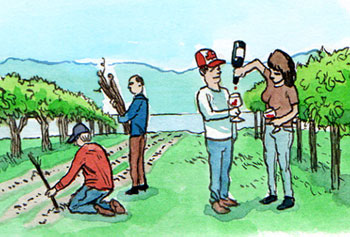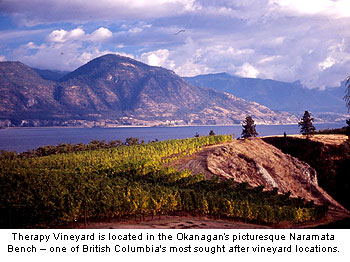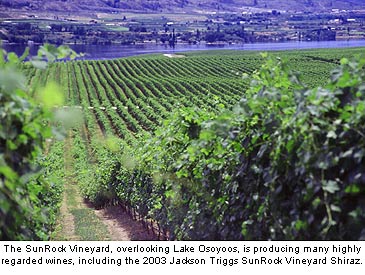

Demand for British Columbia wine will continue to outpace supply until new vineyard plantings are mature enough to produce quality fruit.
British Columbia (Provincial Appellation)
British Columbia Vineyard Acreage Takes a Big Jump
"If it is hard for British Columbians to get their own wines, of course, it is next to impossible for the rest of North America to find them. The increase in vineyard production will make some of these wines more widely available and should curtail the rising wine prices."
by
John Schreiner
October 13, 2006
The area under cultivation of wine grapes in British Columbia has risen 21.4% in just two years, and further significant increases are projected.
The province now has 6,632.39 acres (2,653 hectares) of wine grapes, an increase of 1,169.9 acres (473.5 hectares) since 2004.
These figures are from a newly released vineyard census done this summer by Mount Kobau Wine Services, a consulting firm in the Okanagan Valley operated by industry veterans Lynn and John Bremmer.
And more grapes are on the horizon. Another 769.72 acres (311.5 hectares) are expected to be planted in 2007 and a further 600 acres (243 hectares) in 2008.
According to the Bremmers, the impact of the current and projected plantings, will be to increase British Columbia’s potential grape production from an expected 20,923 short tons this year to 30,000 tons in 2010. Based on average production levels, this translates to an expected increase in wine production from 11,507,650 litres in 2006 to 16,521,450 litres in 2010.
That news is expected to be greeted warmly by consumers, who are becoming frustrated that all the best wines either sell out in hours or are on limited allocation. A perfect example of this was the recent release of Burrowing Owl Vineyards’ 2004 Merlot. With a production of only 7,000 cases, it was so tightly allocated that a major private wine store in Vancouver limited sales to one bottle per customer.
 If it is hard for British Columbians to get their own wines, of course, it is next to impossible for the rest of North America to find them. The increase in vineyard production will make some of these wines more widely available and should curtail the rising wine prices. However, relief is some years away.
If it is hard for British Columbians to get their own wines, of course, it is next to impossible for the rest of North America to find them. The increase in vineyard production will make some of these wines more widely available and should curtail the rising wine prices. However, relief is some years away.
This is the third comprehensive vineyard census done by the Bremmers. In 1999, the year of their first census, British Columbia had 4,184 acres (1,693 hectares) of wine grapes. The low point in vineyard acreage in recent history was 1989, after a massive pullout of mediocre varieties removed two-thirds of the vines. Vineyard acreage after the removal was only an estimated 1,300 acres (526 hectares).
The ultimate potential vineyard acreage in British Columbia remains to be determined. Ben Stewart, one of the owners of Quails’ Gate Estate winery and a veteran grower, predicts that acreage will peak at 10,000 acres (4,047 hectares).
These are highlights from the latest census:
~ John Schreiner, Regional Correspondent – British Columbia
To comment on John Schreiner’s writings and thoughts, contact him at j.schreiner@appellationamerica.com
The province now has 6,632.39 acres (2,653 hectares) of wine grapes, an increase of 1,169.9 acres (473.5 hectares) since 2004.

These figures are from a newly released vineyard census done this summer by Mount Kobau Wine Services, a consulting firm in the Okanagan Valley operated by industry veterans Lynn and John Bremmer.
And more grapes are on the horizon. Another 769.72 acres (311.5 hectares) are expected to be planted in 2007 and a further 600 acres (243 hectares) in 2008.
According to the Bremmers, the impact of the current and projected plantings, will be to increase British Columbia’s potential grape production from an expected 20,923 short tons this year to 30,000 tons in 2010. Based on average production levels, this translates to an expected increase in wine production from 11,507,650 litres in 2006 to 16,521,450 litres in 2010.
That news is expected to be greeted warmly by consumers, who are becoming frustrated that all the best wines either sell out in hours or are on limited allocation. A perfect example of this was the recent release of Burrowing Owl Vineyards’ 2004 Merlot. With a production of only 7,000 cases, it was so tightly allocated that a major private wine store in Vancouver limited sales to one bottle per customer.
 If it is hard for British Columbians to get their own wines, of course, it is next to impossible for the rest of North America to find them. The increase in vineyard production will make some of these wines more widely available and should curtail the rising wine prices. However, relief is some years away.
If it is hard for British Columbians to get their own wines, of course, it is next to impossible for the rest of North America to find them. The increase in vineyard production will make some of these wines more widely available and should curtail the rising wine prices. However, relief is some years away.This is the third comprehensive vineyard census done by the Bremmers. In 1999, the year of their first census, British Columbia had 4,184 acres (1,693 hectares) of wine grapes. The low point in vineyard acreage in recent history was 1989, after a massive pullout of mediocre varieties removed two-thirds of the vines. Vineyard acreage after the removal was only an estimated 1,300 acres (526 hectares).
The ultimate potential vineyard acreage in British Columbia remains to be determined. Ben Stewart, one of the owners of Quails’ Gate Estate winery and a veteran grower, predicts that acreage will peak at 10,000 acres (4,047 hectares).
These are highlights from the latest census:
- Grape growing is concentrated in the Okanagan Valley, which at the present time accounts for 85.9% of the vineyard acreage. The neighbouring Similkameen Valley has only 5.1% of the acre.
- Vancouver Island’s vineyard acreage is still small, standing at 253.77 acres (102.7 hectares), up from 189.66 acres (76.75 hectares) in 2004.
- There has also been growth in the Fraser Valley, which now has 134 acres (54 hectares) of wine grapes, up from 69 acres (28 hectares) in 2004.
- Wineries own or control (lease) 70% of the vineyard acreage, leaving only 30% in the hands of independent growers.
- Of the 464 vineyards in British Columbia, a significant number are small. The average size of those owned by independent growers is 7.2 acres (2.9 hectares). There are only 20 winery vineyards and three independent vineyards that are more than 40 acres (16 hectares) in size.
- The number of wineries is rising dramatically. The Bremmers report that there currently are 118 licensed grape wineries, with 50 more proposed. In addition, there are 21 producers of cider, mead or fruit wines, with a handful more under development.
- The current winery population is up from 90 licensed wineries in 2004 and 61 licensed wineries in 1999.
- Red grape plantings have pulled ahead of whites. In 2006, red vinifera account for 51.71% of total plantings, up from 49.44% in 2004 and 46.31% in 1999.
- Hybrid varieties, which dominated British Columbia prior to the pullout, now comprise only 2.2% of total acreage -- a percentage that has been declining steadily. Most of that is Marechal Foch, a favourite in the cooler regions because it ripens early and reliably.
- Merlot is the dominant red variety, accounting for a third of all the red grapes in British Columbia, at 1,144.61 acres (463.2 hectares).
- Chardonnay remains the dominant white, 21.86% of all white varieties, at 699.88 acres (283.24 hectares).
- Rising stars among the red varietals include Cabernet Sauvignon, which has inched ahead of Pinot Noir to become the second most widely planted red, at 599.81 acres (242.7 hectares). Syrah has moved ahead of Cabernet Franc to become the fourth most widely planted red, at 337.89 acres (136.7 hectares).
- Rising stars among the whites include Sauvignon Blanc, which has pulled ahead of Riesling to become the fifth most widely planted variety at 292.56 acres (118.3 hectares). Viognier in two years has shot up to ninth spot from 13, and now accounts for 52.36 acres (21.2 hectares).
click on the links below to see the details of Bristish Columbia’s latest vineyard census:
acreage of white wine varieties
acreage of red wine varieties
acreage of white wine varieties
acreage of red wine varieties
~ John Schreiner, Regional Correspondent – British Columbia
To comment on John Schreiner’s writings and thoughts, contact him at j.schreiner@appellationamerica.com












